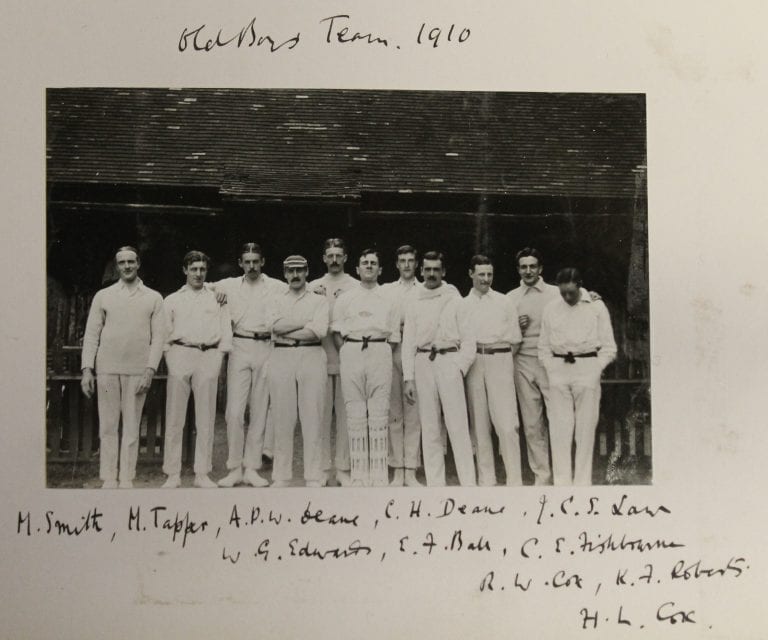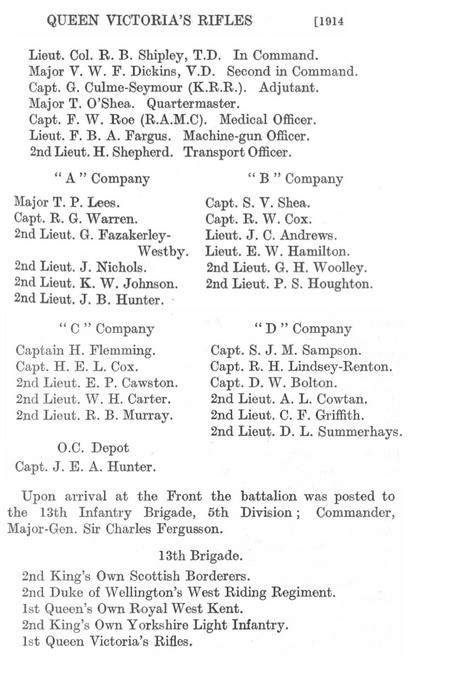
Colonel Reginald Woodruff Cox OBE was born on 16 August 1883 the son of Louisa J Woodruff Cox and Edward William Cox, also a member of this Lodge. He had one sister Constance and a younger brother, Harold Edward Leys Cox.
He attended St George’s School and sang in the choir between 1894 and 1899. He sang with his younger brother Harold, and both would become silk merchants in the family firm of Cox & Edwards of Old Cavendish Street, London, established by their father and Howard Edwards. Reginald joined the firm in 1908. They are shown in the St George’s old boys photograph above, R W Cox third from right and Harold on the far right.
Both brothers were also members of the Regiment, with Reginald being gazetted 21 March 1905.
Both brothers went to the front at the outbreak of the War and are listed on the Roll of Officers under the command of Lt Col Reginald Shipley that landed at Le Havre in 1914, Reginald with B Coy and Harold with D Coy:

As well as Shipley Cox served brothers ‘Doc’ Roe, Dickins and Hunter. Also with him in B Company was Woolley, who would win the Victoria Cross at Hill 60, the first VC won by a Territorial.
Reginald went on to be promoted Major with the 1st Battalion and Harold as was promoted Captain with the 1st and then 2nd Battalions.
Reginald often wrote in response to a request from the School magazine for real accounts from the front. Though his letters were generally positive and cheery, extracts reveal the grim realities of trench warfare. In Midsummer 1915, he writes:
“no one who has not seen it can have the slightest idea of what the shell fire was like… the noise the shells made going through the air was one of the most awful things one can think of.”
In a letter published in the St George’s School Magazine earlier that year during Easter term 1915, Reginald said:
“I hope Harold and myself will be spared to return and then we shall have plenty of news to give to all our friends.”
Only he would return; Harold was reported missing and presumed dead in Midsummer 1916. His last known movements were recounted by his father in a letter to the School, where he explained that after heavy fighting, Harold and his men were forced to retreat, and seeing that all his men were out of the last trench, he was sheltering when a shell exploded nearby. Harold was seriously wounded and nothing more was heard of him afterwards, even by Christmas 1916.
Harold Cox’s commanding officer wrote:
“If there was any gallantry shewn amongst the officers more than another, our poor little Bantam (Harold) should be singled out.”
The news of Harold’s death reached the Lodge and the boys father at the October 1916 Installation Meeting. Edward Cox was installed but left immediately afterwards, before a sombre festive board.
Reginald Cox survived the war and stayed in France until 1919, before returning home to Ealing. He continued to be an active member of the Old Boys Committee of St George’s and often participated in the annual sports matches. Reginald was an elected member of the Committee when the proposal was made to raise funds for a memorial in St George’s Chapel to the boys lost during the war.
Cox was initiated into the Lodge after the war in January 1920. He worked through the progressive offices becoming Worshipful Master in October 1926. He was Secretary from 1934 to his death on 27 February 1944.
Having been promoted to full Colonel, he served on the Army Officers Selection Board during the Second World War. The night of his death his house received several direct hits from German incendiary bombs, but he is considered not to have been killed on active service.
He was exalted in St Albans Chapter No 29.